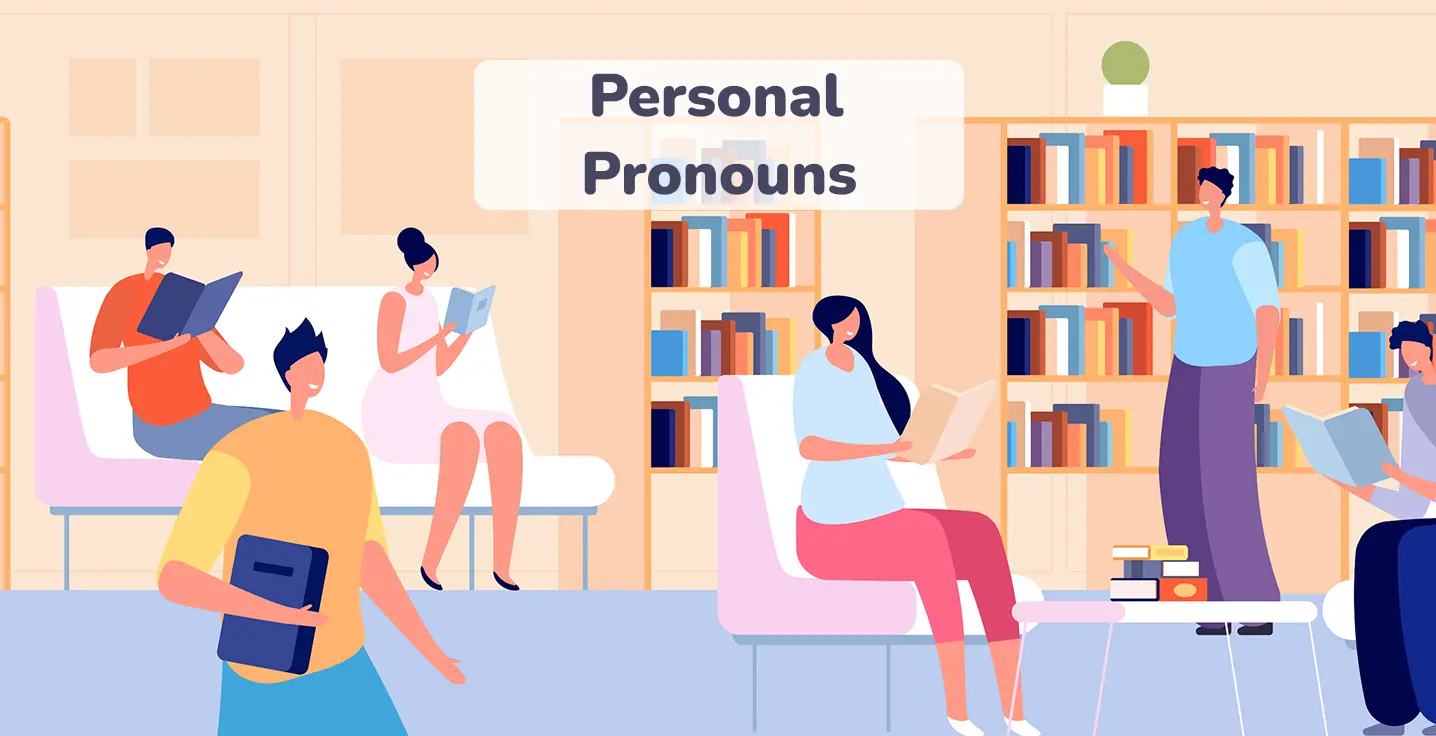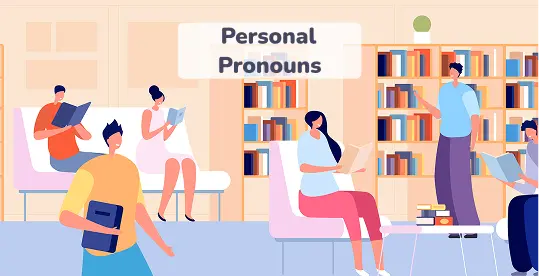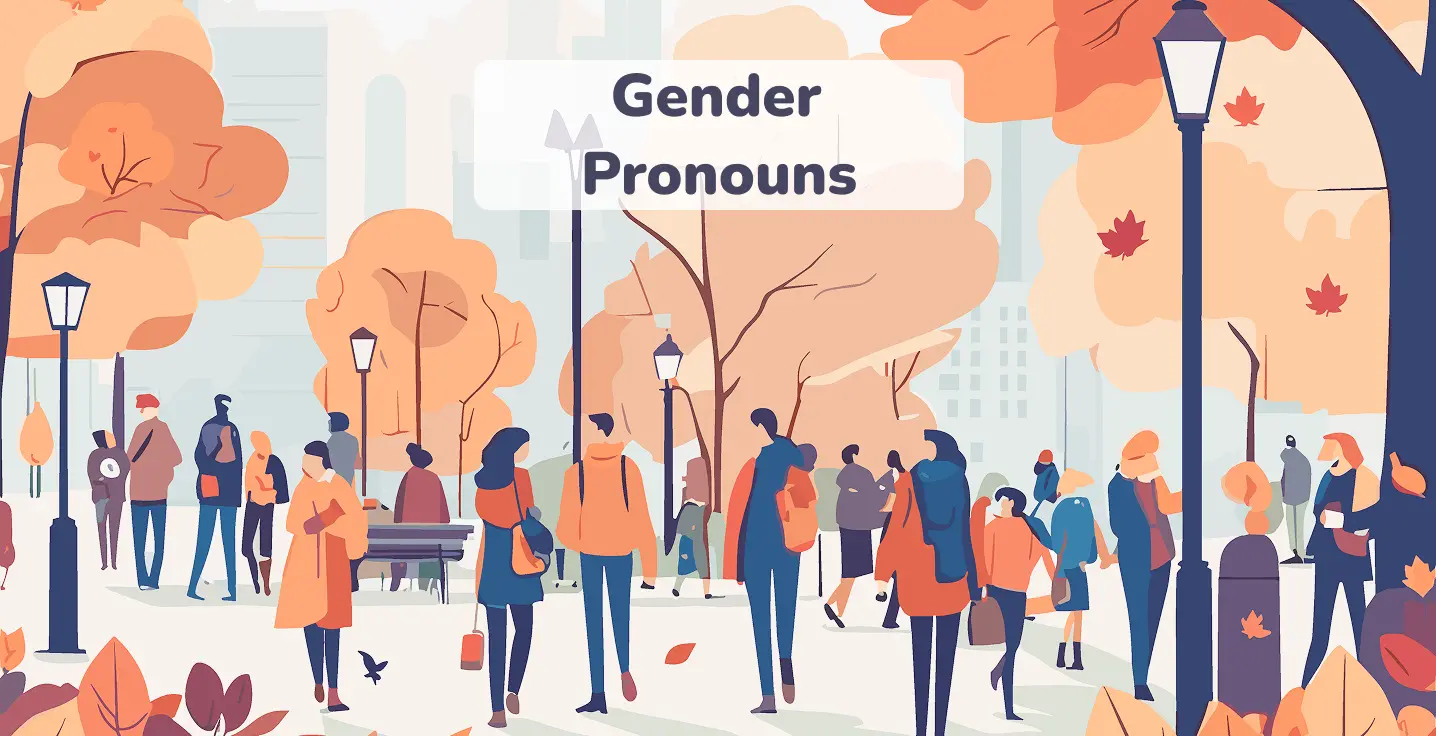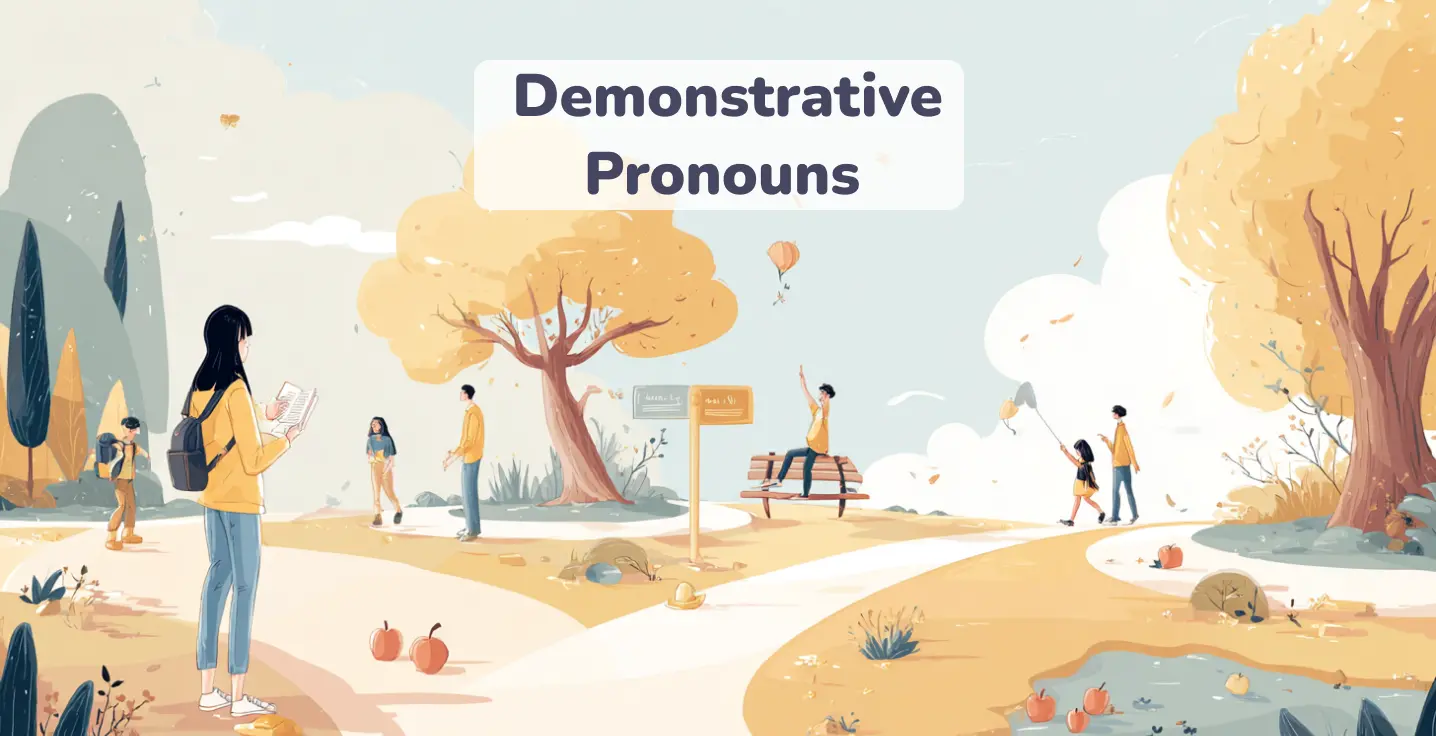What is a personal pronoun in English?
A personal pronoun is one of the words, including I , you , we , they , he , she , it , that we use when discussing people and things.
They take the place of nouns in sentences, helping us be clear about who to refer to and enabling us to cut the number of nouns and names that make our phrases too wordy.
Look at this brief example to quickly grasp their meaning:
| Before | After |
|---|---|
|
Olivia told Olivia’s teacher that Olivia forgot Olivia’s homework at Olivia’s house.
|
Olivia told her teacher she forgot her homework at home.
|
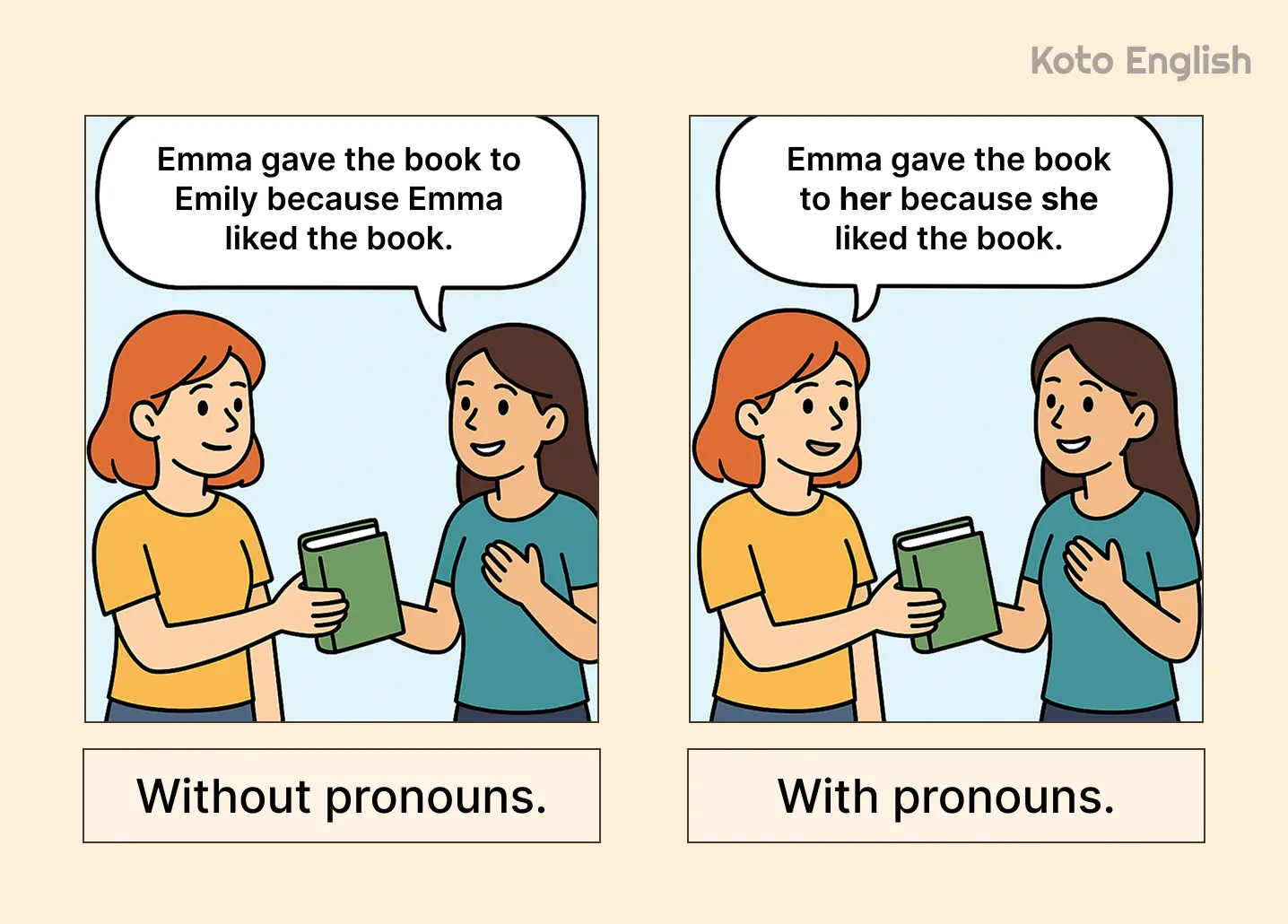
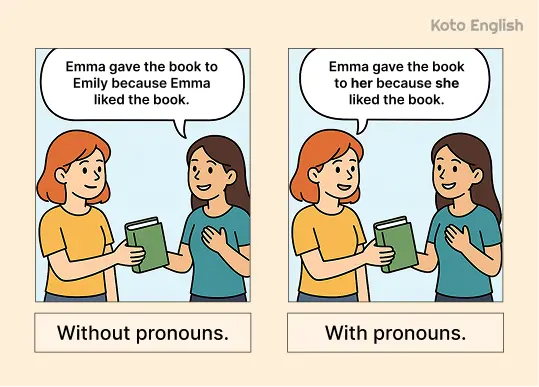
Learners commonly confuse he and she, and their variations, so it is essential to pay special attention to them.
Level up your English with Koto!
Forms of personal pronouns
These are short, yet powerful phrases. They show who is doing something or to whom something is being done. And they change based on their role in the sentence. There are three main types of these pronouns: subject, object, and possessive.
Look at the table to spot the differences between their meaning, rules, and positions.
| Type of a pronoun | Examples | Sentence | Explanation |
|---|---|---|---|
| Subject pronouns | I, you, he, she, it, we, they |
|
Takes the place of the subject and starts a sentence. |
| Object pronouns | me, you, him, her, it, us, them |
He gave
|
Acts as an object; points at who receives the action. |
| Possessive pronouns | mine, yours, his, hers, its, ours, theirs |
This phone is
|
Can be placed as a subject and the object, when you emphasize that a thing you are discussing is yours (theirs, hers, his). |
To use them naturally, practice each group of pronouns separately by writing sentences with them.
When to use them correctly?
With an idea of what exactly a personal pronoun definition is, we can now go ahead and discuss how we will actually use them in real sentences.
- Use them to replace names to avoid repetition
Tired of saying the same name ten times? Swap it for a pronoun:
Maria called.She wants to meet later.I saw David and gavehim the invitation. - Use to refer to known people and things
Victor bought a table.
It was expensive.Sarah found a new job.She is excited. - Use to connect ideas
A personal pronoun helps link different ideas smartly:
Jay runs every day.He wants to stay fit.Alice said that wallet ishers .She forgot it.
It’s all about giving each word from the list of personal pronouns the right part to play: actor (he sings), receiver (we met him), or owner (the bike is his).
How to use personal pronouns?
Let’s see how pronouns actually work when you’re out in the wild — chatting with friends, texting your crush, or explaining to your coworker (for the third time) that they muted themselves again. Below, you’ll see how pronouns are used in positive, negative and interrogative sentences.
In statements
Here are explanations of using each personal pronoun with a concrete case to help you navigate through their applications:
| Pronoun | Example | Case |
|---|---|---|
| I |
|
The speaker refers to themselves. |
| You |
|
Speaking directly to another person (or people). |
| He |
|
Talking about a man. |
| She |
|
Talking about a woman. |
| It |
|
Referring to an object, idea, or animal (when gender isn’t known or needed). |
| We |
|
Referring to a group including the speaker. |
| They |
|
Referring to a group of people or things (not including the speaker). |
In questions
Pronouns help form questions by indicating who the subject or object is. Below are personal pronouns examples showing how to use them to ask for information or clarification.
| Pronoun | Example |
|---|---|
| I |
Am
|
| You |
Are
|
| He |
Is
|
| She |
Did
|
| It |
Will
|
| We |
Do
|
In negative sentences
Pronouns are part of everyday grammar, and they play a key role when expressing what someone doesn’t do, have, or like.
| Pronoun | Example |
|---|---|
| I |
|
| You |
|
| He/She |
|
| It |
|
| We |
|
| They |
|
Now that you’ve seen them play every role from solo star to team player, you’re ready to let them handle heavy-lifting in grammar while you focus on what to say next.
Examples of each personal pronoun in action
Below, you’ll find instances where these tiny words do big jobs: they act, they react, and sometimes, they take ownership like proud grammar heroes.
In daily conversations
All pronouns are actively used in everyday English.
Note that when you want to refer to several people, you use we when you include yourself in the dialogue (you + 1 other person and more). If you’re discussing two or more people, you use they/them. Look at the examples of this personal pronoun:
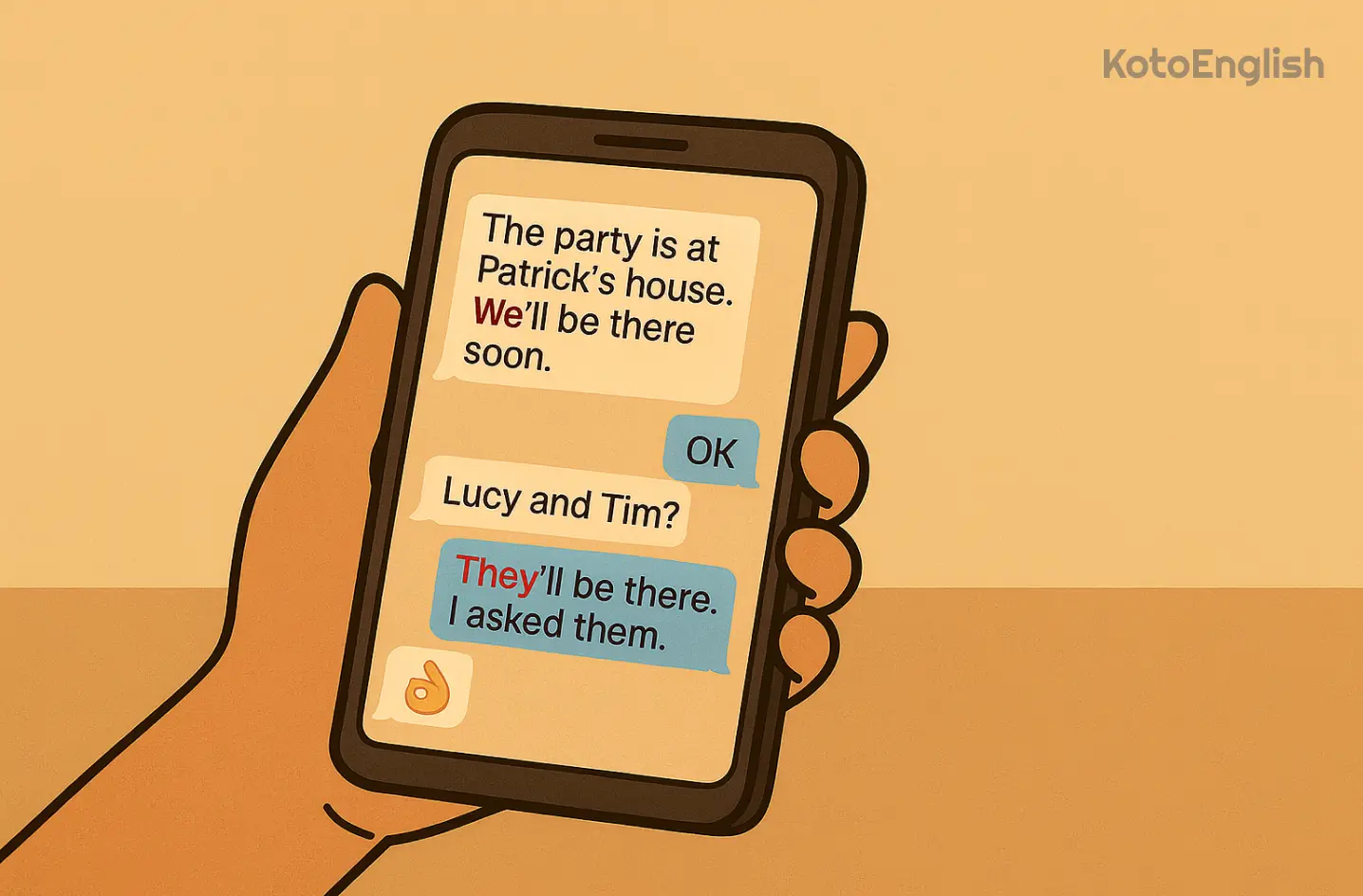
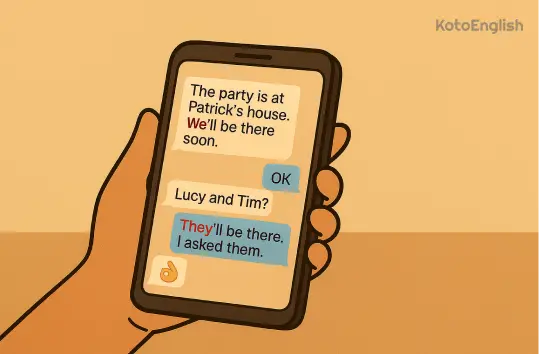
Abby: What about Lucy?
Brianna:
Practice replacing the nouns that refer to groups, such as my friends, my parents, his colleagues, their neighbors.
Speaking about general facts
In English, when you want to discuss the weather, the temperature or whenever you want to use an adjective like cold, cool, sunny and many others, you usually use it’s before the adjective:
Beth:
Adrian:
Try to write your own sentences with the following adjectives and it’s to make it natural: small, big, late, early, cloudy.
In formal writing
In more structured settings, like emails, essays, or reports, they are still useful. While you may use them more carefully, referring to a personal pronouns list can help you choose the right words to keep your writing clear and direct.
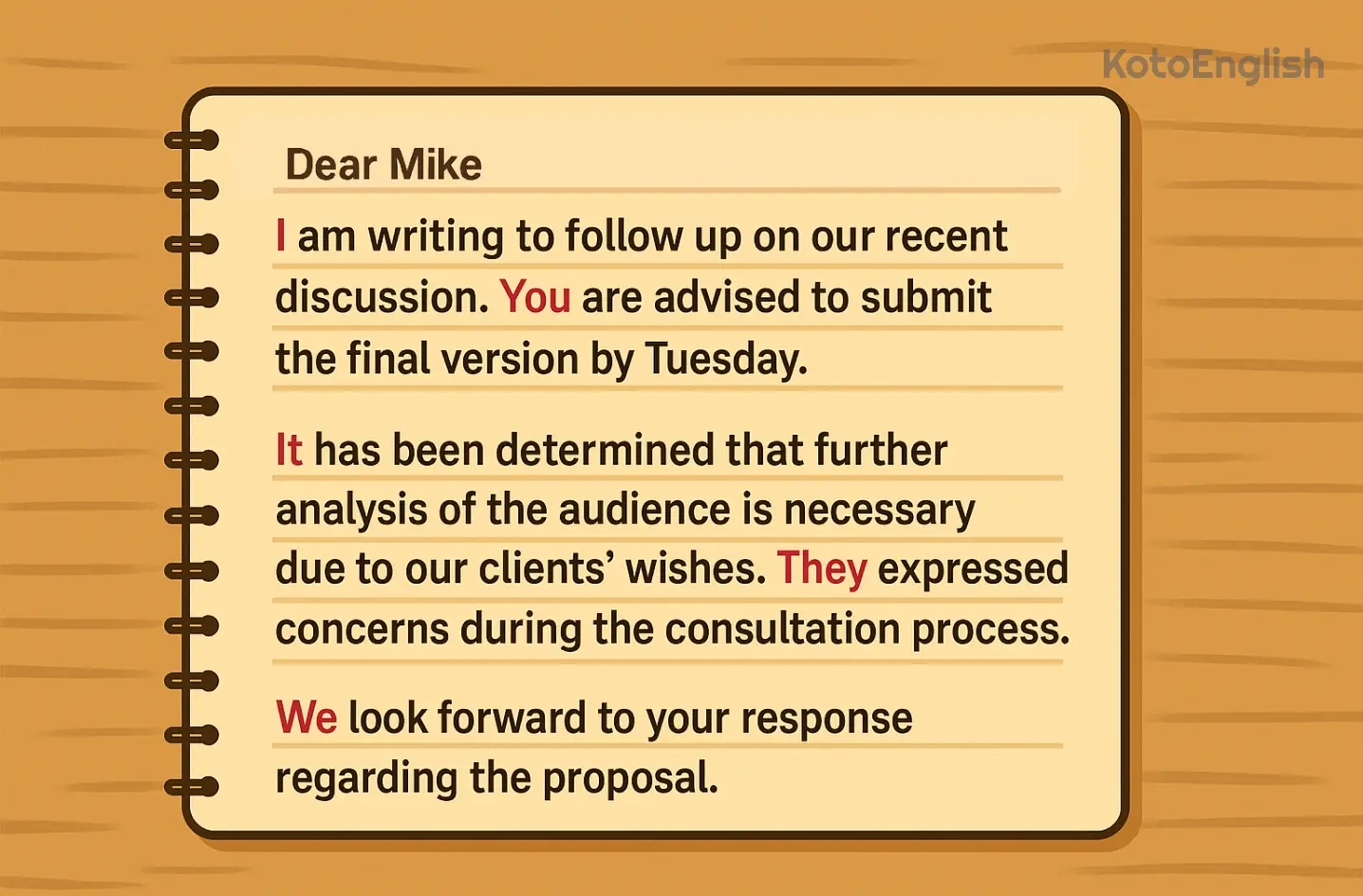
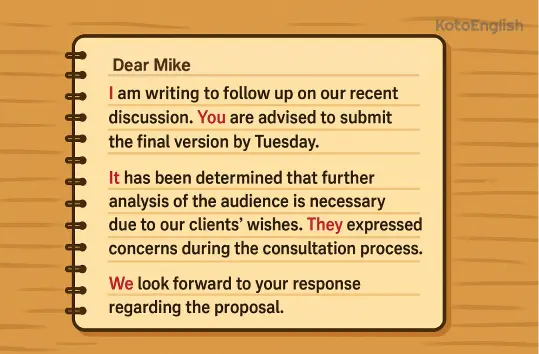
Common mistakes
Knowing where people typically stumble gives you a head start. Here are some classic personal pronoun examples of common slip-ups and how to dodge them with confidence.
Subject vs. object confusion
A common pitfall, especially for beginners, is mixing up subject and object pronouns.
|
Me like eating out with friends.
|
I like eating out with friends.
|
|
We saw she in a countryside village.
|
We saw her in a countryside village.
|
Use the subject pronoun when it does the action, and the object pronoun when it receives it.
Misusing it for people
Do you use it for people? That’s where things go off track. Here’s how to handle introductions or descriptions involving humans:
|
It is my mom, Helena.
|
She is my mom, Helena.
|
|
It is my uncle visiting us.
|
He is my uncle visiting us.
|
It works perfectly when talking about things, animals (when the gender is unknown), or abstract ideas.
Overusing myself instead of me or I
People often throw myself into sentences where it doesn’t belong, especially in formal contexts.
|
Please send the document to John and myself.
|
Please send the document to John and me.
|
|
Myself and Alex will handle the report.
|
Alex and I will handle the report.
|
Reflexive pronouns like myself have a very specific role, usually when the subject and object are the same person.
Personal vs. possessive pronouns
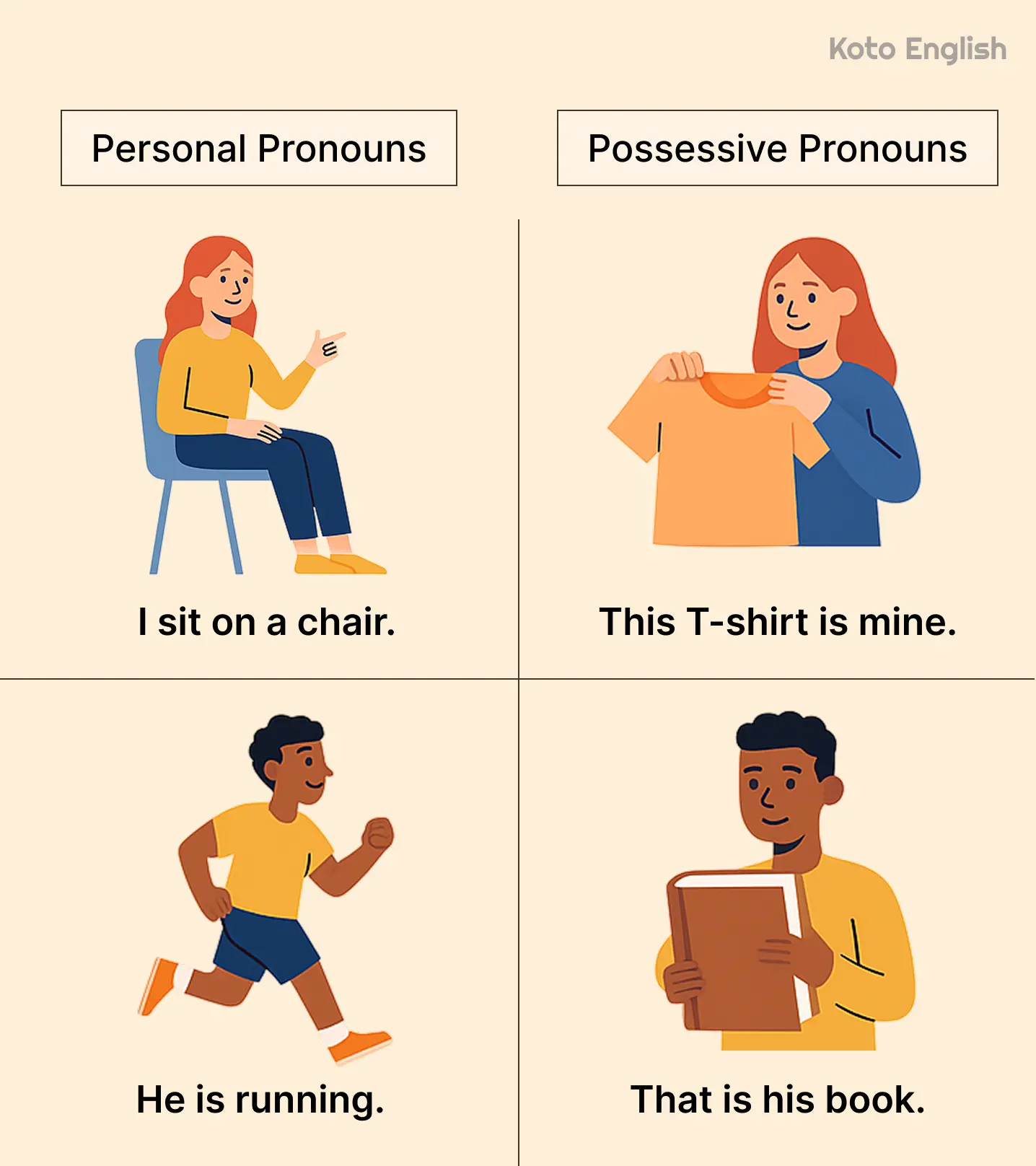

Personal and possessive pronouns in English are like cousins at a family reunion. They look a little alike, hang out in the same sentence, but each one has a different job to do. Comparing alongside possessive forms makes the differences clear. Let’s break it down.
-
Personal pronouns: the cast of characters
What are personal pronouns? They are the words that stand in for people or things doing the action or receiving it. Think of them as the main characters in your sentences.
| Role | Singular | Plural |
|---|---|---|
| First person | I / me | we / us |
| Second person | you | you |
| Third person | he / him, she / her, it | they / them |
Examples:
- Possessive pronouns: who owns what
These are all about showing ownership. They replace the noun entirely or show to whom something belongs.
Possessive adjectives: my, your, his, her, its, our, their
Possessive pronouns: mine, yours, his, hers, its, ours, theirs
Examples:
Notice the difference?
Personal: points to a person or thing.
Possessive: shows who owns it.
When the word comes before a noun (my bag, her car, their advice), it is a possessive adjective. Used on its own to replace the noun (mine, yours, theirs), it becomes a possessive pronoun.
Tips for learning and practicing
Go beyond the personal pronouns definition and learn how to apply the target words in speaking and writing:
Tip 1. Master subject pronouns first
Understand how to use I, you, we, they, he, she, and it before diving into the object and possessive forms. Pick a list of singular and plural nouns and practice replacing them with pronouns.
Tip 2. Enforce them with instances
Our examples of personal pronouns used in dialogues and sentences will guide you in studying. Memorize pronouns in context, as it will help you to use them in practice better than if you just learn the list.
Tip 3. Try practicing them in speaking
Simple phrases said aloud five minutes a day will enable you to stick this grammar to your memory and move on to the next topic.
Summary
Pronouns are short words that give you more freedom to share your thoughts, and it is essential to know all the details of their usage when you learn English. Repeat the rules, write sentences, and pronounce them until you fully understand the personal pronoun meaning and can recite them from your memory.
Enjoy personalized learning!
Personal pronouns FAQ
Some pronouns should be capitalized when they start a sentence, as all the other words do. For example:
However, when used in the middle of a sentence, they are written in the lower case: You know that
A quick trick: if the pronoun is doing something, go with I. If something’s being done to it, pick me.
Sure, you can use they to refer to one person in the following cases:
- You don’t know the gender of a person, dealing with some Alex Smith or Charlie Brook. They is a safe option.
- You speak to the general audience (users, students, employees), and gender doesn’t play a significant role. It is an accepted alternative to he/she writing.
It replaces singular objects. For example: My phone fell off the table. —
So, the simple answer is no. They and It are not interchangeable, because one is plural and the other is singular.
A personal pronoun changes the subject of a sentence to show that someone does something. Reflexive pronouns help describe the idea when the subject and object are the one person, which acts and receives the action.



